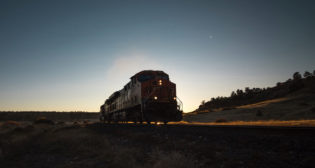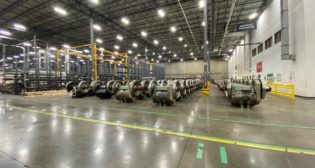
IHB going CNG
Written by William C. Vantuono, Editor-in-ChiefThe Indiana Harbor Belt Railroad (IHB) is partnering with OptiFuel Systems LLC and R.J. Corman Railpower Locomotives LLC to convert its entire locomotive fleet to compressed natural gas (CNG).
OptiFuel has shipped its “100% U.S. designed and manufactured” dual-fuel (diesel and CNG) locomotive engine systems to IHB) for integration into the first two of 31 CNG Tier 4 switcher locomotives for IHB’s CNG Repower Program. The dual-fuel system includes OptiFuel-designed on-board CNG storage units and a trackside CNG refueling station.
IHB is the first railroad in the U.S. to convert its fleet to CNG, described as “the least carbon-intensive fossil fuel,” as its primary fuel source. IHB contracted system design, assembly and integration of the entire CNG system to OptiFuel Systems, and the overall locomotive design, assembly, and integration to R.J. Corman
 “The CNG Repower Program represents a substantial investment to change our locomotive fleet to CNG and eliminate harmful emissions,” said IHB Director of Mechanical Operations Michael Nicoletti. “The locomotives are a part of a greater effort by the IHB to convert up to 31 of our locomotives to be powered primarily by CNG. At the end of the program in 2020, 70% of IHB’s fleet will be converted to utilizing CNG as its primary fuel source. Introducing CNG as a viable fuel into the freight rail industry is a role that the IHB embraces in both its unique challenges and operational and environmental rewards.
“The CNG Repower Program represents a substantial investment to change our locomotive fleet to CNG and eliminate harmful emissions,” said IHB Director of Mechanical Operations Michael Nicoletti. “The locomotives are a part of a greater effort by the IHB to convert up to 31 of our locomotives to be powered primarily by CNG. At the end of the program in 2020, 70% of IHB’s fleet will be converted to utilizing CNG as its primary fuel source. Introducing CNG as a viable fuel into the freight rail industry is a role that the IHB embraces in both its unique challenges and operational and environmental rewards.
“OptiFuel is pleased to be a first-mover and developer of technology applying environmentally compliant dual fuel systems to the railroad switching industry,” said OptiFuel Systems President Scott Myers. “OptiFuel’s technology will provide needed solutions and support to the Class I, II and III railroads as they seek ways to mediate the recognized adverse environmental impacts of their aging switcher fleets. As of September 2016, there were more than 1,000 railyards in the U.S. located in densely populated, urban areas classified as particulate matter and ozone EPA-defined ‘nonattainment’ areas. More than 119 million people—nearly 40% of the U.S. population—living in these nonattainment areas are experiencing acute and chronic adverse health problems, including exacerbation of respiratory and cardiovascular disease.
“In U.S. railyards, there are more than 8,000 very old, diesel-powered switcher locomotives, 95% of which produce Pre-Tier 0 (non-regulated, pre-1973) emissions. These Pre-Tier 0 pollutants create high levels of ozone, air toxics, greenhouse gases, fine particulate matter (PM) and other diesel exhaust compounds classified as carcinogenic to humans.”
“Each of these Pre-Tier 0 switcher locomotives put out emissions equal to 72 new Tier 4, Class 8 diesel trucks. Replacing the switchers has priority over replacing old Class 8 trucks since, from a purely emission and dollar funding savings standpoint, it is four times more efficient to replace Pre-Tier 0 switcher locomotives with new Tier 4 CNG switcher locomotives than to replace old Class 8 trucks with new Tier 4 Class 8 trucks. Now that the technology exists to provide affordable Tier 4, CNG-powered freight switchers, all the states and associated railroads have the option to replace their Pre-Tier 0 freight switchers with new Tier 4 CNG freight switchers with commensurate fuel cost savings while expanding the country’s use of domesticated natural gas.”
Myers noted that additional funding support could come from the Volkswagen Settlement, which provides $2.7 billion under an Environmental Mitigation Trust for remediation of NOx emissions.
Twenty-one of the IHB locomotives will feature a 1,500-hp twin-engine configuration using two OptiFuel Systems-designed 750-hp, dual fuel engines that meet or exceed all federally mandated Tier 4 emissions reduction categories. As compared to IHB’s current locomotive fleet, particulate matter (PM) and nitrogen oxides (NOx) should be reduced by 94.7% and 85.3%, respectively. In addition, an Automatic Engine Start-Stop (AESS) system will shut down idling locomotives to further reduce by 25% to 50% fuel and oil consumption, lower emissions, and mitigate noise and engine wear.
Mainstay Fuel Technologies, Inc. of Greenville, S.C., under a subcontract with OptiFuel, engineered and manufactured the modular CNG on-board storage system. “The design incorporates important features and elements of Mainstay’s established fuel systems that are used in Class 8 truck markets,” Myers said.
The design, which includes eleven 5,000-psi Hexagon Lincoln, DOT-approved Type IV cylinders, was engineered to handle switcher locomotive operational loads and meet Federal Railroad Administration (FRA) recommendations and requirements. Based on the current IHB duty cycle, the on-board system storage of 700 DGE will handle 7 to 10 days of operation before refueling is required. The standard diesel tanks on the locomotives are not reduced in size, allowing 100% diesel operation if needed.
ANGI Energy Systems, also under a subcontract to OptiFuel, manufactured the Trackside CNG Refueling Station equipment. “As a premier packager and manufacturer of CNG equipment for the CNG trucking, transit and bulk storage market, ANGI took the OptiFuel system requirements and created and manufactured a low-risk, proven, modular CNG station that can refuel two locomotives every 15 to 30 minutes in the basic configuration and four locomotives every 15 to 30 minutes in a growth configuration,” Myers noted. “During the system design process, the team developed CNG dispensers, locomotive-to-refueling equipment communications, locomotive RF tagging and system safety approaches and requirements, based on standard best practices used in the rail industry.
“All of the CNG components are designed to be modular, scalable, reliable and affordable for use in a locomotive configuration. In addition, during the next 12 to 18 months, OptiFuel will be expanding its line of EPA-certified Tier 4 dual-fuel engines for the rail market, from 600 hp to 3,000 hp, and a line of Near Zero NOx/PM (proposed Tier 5) CNG equipment from 900 to 3,300 hp for rail OEMs. These engines will support single-engine or multiple-engine locomotive configurations and different modular onboard CNG storage sizes.
“We expect that the incremental cost to repower older switcher locomotives and/or build new switcher locomotives with CNG and dual fuel will be around 10% to 15%, based on the IHB program. However, we think that the savings in fuel economy, increased safety, lower risk, and cleaner emissions will make financial sense to large and small railroads, particularly if a leasing program and an integrated, cost-effective CNG refueling program is also provided.”
The IHB’s CNG Repower Program is supported by federal funds through the Congestion Mitigation and Air Quality (CMAQ) Program, administered by the Chicago Metropolitan Agency for Planning (CMAP). The IHB’s sponsor is the Illinois Environmental Protection Agency.
Based in Beaufort, S.C., OptiFuel Systems LLC “is leading the transportation market with innovative dual-fuel natural gas high horsepower solutions, including the developing of natural gas high-horsepower engines, onboard natural gas (both CNG and LNG) storage systems, and natural gas refueling systems for the rail, marine, power and other mobile markets,” as the company describes itself. “Currently, OptiFuel is expanding its line of EPA certified, Tier IV, dual fuel (natural gas/diesel) solutions from 600 to 5,400 hp for rail and coastal/inland marine OEMs and will have, in 2018, a line of Near Zero NOx/PM (proposed Tier 5), natural gas solutions from 900 to 3,300 hp for rail OEMs.
The Indiana Harbor Belt Railroad, located in Chicago and northwest Indiana, is the largest terminal switching railroad in North America. The IHB provides service to more than 100 industrial customers, and interchanges with 17 railroads including six Class I railroads across its 35 miles of main line and 350 miles of yard and siding tracks.
Based in Piedmont, S.C., Mainstay Fuel Technologies, Inc. specializes in designing, engineering and producing CNG fuel-delivery systems. The company provides products and services for Class 7 and 8 heavy-duty vehicles, including garbage trucks, concrete mixers, vocational trucks and over-the-road tractors. The company also offers products and services for Class 3 through 6 medium-duty work trucks, service vehicles and commercial buses. Since 2006, the company has produced and sold more than 5,800 units/systems for medium- and heavy-duty commercial vehicles.
Founded in 1983, ANGI Energy Systems, a wholly owned subsidiary of Gilbarco Veeder-Root, a worldwide supplier of retail and commercial fueling operations, is a North American company that designs and manufactures systems for CNG vehicle fueling and tube trailer transport applications around the world. ANGI is supplier of CNG refueling equipment for natural gas vehicles, “and has a standing reputation as a leader in the high pressure compression industry,” the company says. “ANGI provides project management, maintenance, and training programs that enable a complete and optimized natural gas refueling system solution for all systems CNG.”
R. J. Corman Railpower Locomotives LLC, a subsidiary of R. J. Corman Railroad Group LLC, designs, builds and currently supports 165-plus locomotives at more than 20 locations around the U.S. Other R. J. Corman companies provide services to the railroad industry such as industrial railcar switching, emergency response, track material distribution and logistics, track construction, signal design and construction, and railroad worker training. In 2000, Railpower Locomotives began developing “a family of clean and efficient switchers … with industry leading 33% adhesion, up to 60% fuel savings and the highest power density,” including Tier 3 and Tier 4 locomotives that meet Class I, II, and III railroad and industrial switching needs.”



